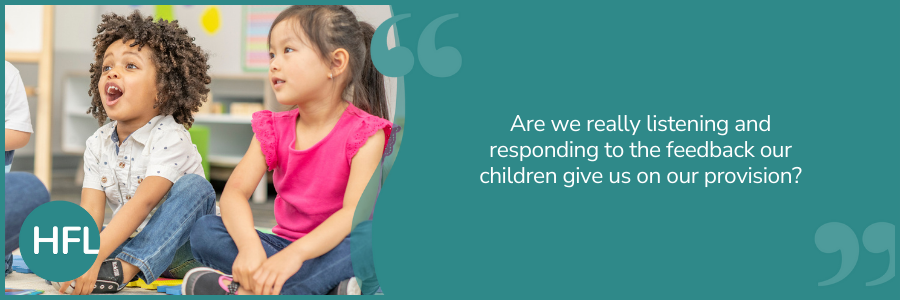

So, we have made it to the end of the summer term, and it is my favourite term in education, not only because the weather is nicer, and children can spend so much time outside but is the term you get to really see the children blossom. Your provision will look quite different in the summer term to how it looked in the autumn term, because your children are now confident and capable in their surroundings. All the skills you have been embedding and teaching often come to fruition in the summer term. The children can display their independence skills as well as those other skills we have been supported them to acquire like perseverance, curiosity, and communication.
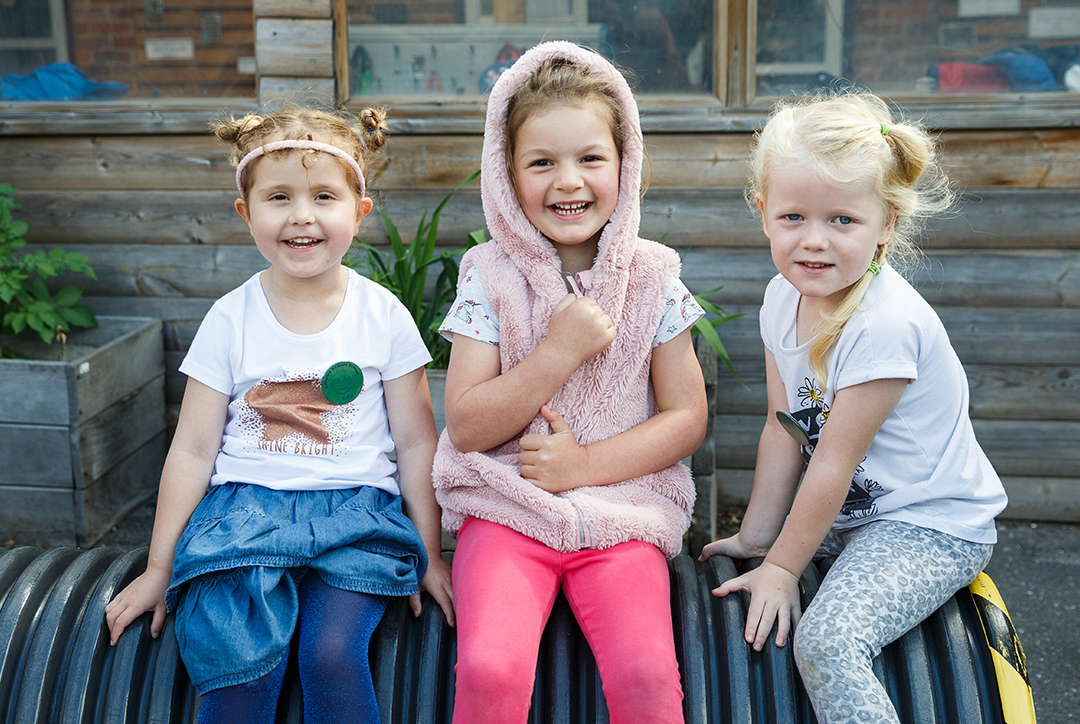
The rights of the child tell us that children have the right to have their voices heard. The children are often their most confident in the summer term, so this makes it the ideal time to ask them to give you feedback on their experiences in your provision and routines of the day.
Ask the children what they have enjoyed, what they struggled with. What would they like to tell the next cohort of children joining the setting or class?
In a previous role as the Under Fives Participation Officer, I conducted many consultations with young children. It was during one of these consultations, a child confidently stated that they “hate the carpet, it ruins my life.” Strong feelings for a young child, and this view was shared by many children across a variety of settings, albeit not so strongly!
When we gather a child’s voice, we need to acknowledge it and consider what the child is telling us and how we can we make the carpet session a place of excitement and joy for children.
Are there any times in your routine that your children have an opportunity give you feedback? what have you done when hearing or observing their views?
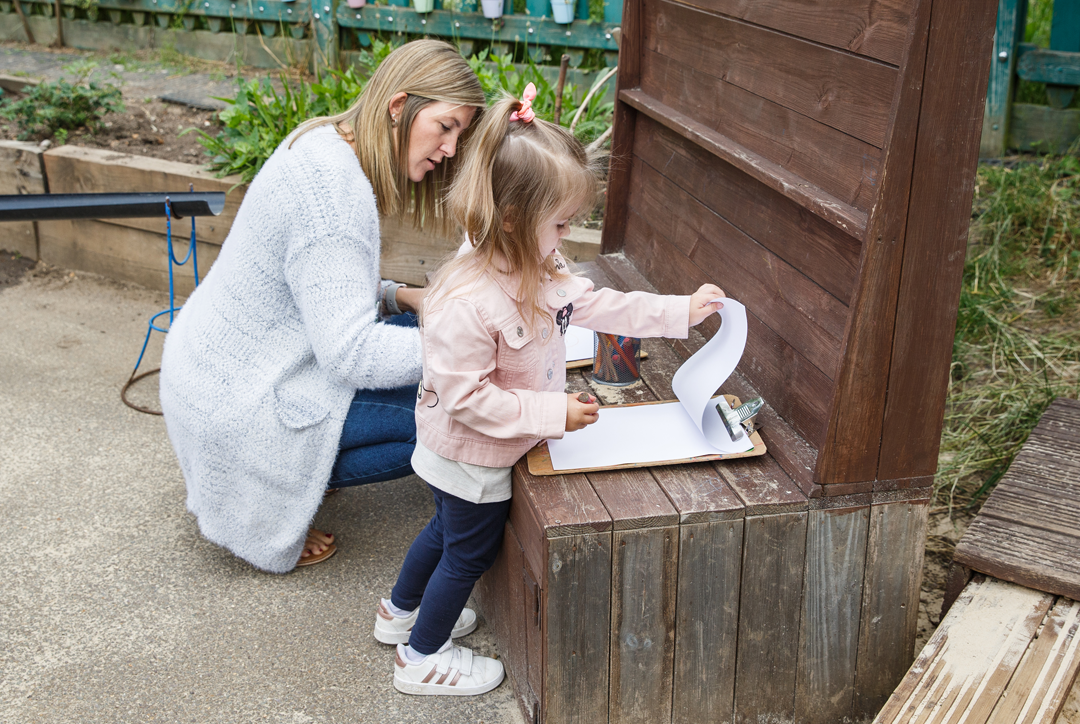
How often are you listening to the children to influence the provision you provide? We must remind ourselves that true consultation is more than “they asked for the dinosaurs, so we put them out.”
We should empower the children to have their own ideas, thoughts and allowing children to plan, problem solve, and experiment. Observing the mastering of these skills in children is one of my favourite things to see in early years children. The pride they exude when they have been trusted with the responsibility to lead on something or work together with others is so powerful in their journey to becoming confident competent learners.
The United Nations Convention on the Rights of the Child (UNCRC) supports this when it tells us in article 12 and 13 that children have a right to be heard and to express their views and thoughts.
“Article 12 (respect for the views of the child)
Every child has the right to express their views, feelings and wishes in all matters affecting them, and to have their views considered and taken seriously. This right applies at all times, for example during immigration proceedings, housing decisions or the child’s day-to-day home life.
Article 13 (freedom of expression)
Every child must be free to express their thoughts and opinions and to access all kinds of information, as long as it is within the law.”
The British Values in Early Years also advise us to model democracy in action, support children in making decisions together as well as encouraging liberty and freedom for all. How are you empowering children to have a voice and use their voice in your setting and in their interactions with others?
With all this in mind, I wanted to offer some reflection prompts to help you consider the ways in which you gather the children’s views, thoughts, and ideas. Building on those developing skills as competent learners that want to investigate and find out more about the world and others in it.
If this blog has sparked an interest in listening and consulting with your early years children and you would like to find out more about the variety of ways, we can consult with young children. You can access the Hertfordshire participation toolkit to support your journey.
Voice of the child: A participation toolkit for practitioners
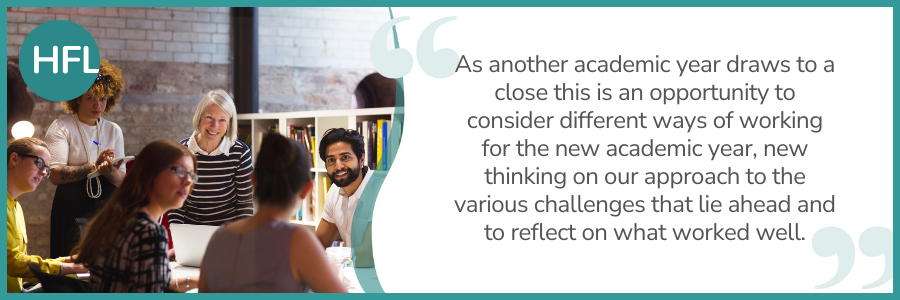
Without doubt the past academic year has had its moments of challenge not least the political turmoil that has resulted in 5 Secretaries of State for Education in 12 months, the ongoing education strikes, budget uncertainty on key areas such as staff pay, the convulsions at Ofsted in the wake of the Ruth Perry tragedy, the threats and opportunities presented by AI and various dire warnings in the media around an epidemic of vaping in schools, crumbling school estates, the ongoing challenge of asbestos in school buildings of a certain vintage, persistent absence on the increase and much more besides. All of this creates challenge for boards and governors alike, a fog of negative stories and influences that conspire to hinder schools in their primary objective of improving outcomes for all their pupils and closing the disadvantaged gap.
As governors and boards, we need to be able to contextualise the above and keep it in perspective, some or all of the above will have an impact on our individual schools but we can do a lot by ensuring that our work remains focussed on outcomes and the strategic journey our school is on to achieve these. Can we work smarter? Can we improve our practice? Can we learn to do things differently? The answer is of course ‘yes we can’! So, the following are some suggested new academic year’s resolutions to help you on your way:
Do we need an endless round of committee meetings to underpin the work of the board or is it possible to roll some, or all, of that work into our FGB meetings? Many boards are moving to the ‘circular’ model of governance and dispensing with the work of committees altogether, others are gradually consolidating committees to focus and reduce workload, recognising the enormous amount of duplication and repetition that occurs for both governors and SLT members. Either way it's about questioning the way you are set up and challenging the reasons why you are where you are and to consider if changes can be made. Please do reach out if you would like to understand more about different ways of working.
When considering the above, even if you make no changes, staff and governors time is precious so meetings need to be smart. A timed agenda is a great place to start, this means setting times in the margin for each item and therefore fitting the proposed business within a set timeframe, ideally 2 hours maximum. If you start at 6pm with a bit of practice and discipline your meetings will be finished by 8pm – the impact on the quality of debate and engagement can be amazing, knowing when a meeting will end gives renewed purpose and motivation to those in attendance.
There is nothing that unites a group of people more than a shared experience whether that be joint training, a school visit or attending a school event. When governors train together, they learn together, the training can be put in context for our own setting and apply that newly acquired knowledge with the confidence that all on the board will be equally informed. This can be done by attending a programme of agreed face to face training or by using a platform such as Modern Governor to set out an annual programme of learning that is undertaken half-termly, fitting neatly around work life commitments, which will ensure that the board acquires knowledge in a planned and strategic way. This can feed into supporting governors link roles so that when visiting school either individually or as a group on a governor’s session in school we can be on the front foot, knowledgably seeking out evidence that helps us triangulate with what we are being told at meetings and the internal and external reports we receive. Training together, visiting together (when possible) and meeting together ensures the workload and lived experience of school life is shared, considered, feeds into our monitoring of school and board plans and ultimately fulfils the strategic role at the core of our work.
Unless we tell our pupils, parents and community about the work we do no one else will! Use the tools at our disposal, for instance go beyond the guidance on what boards need to publish on the school website, use this parent and public facing window to shed light on our work and the impact it’s having. Share photos of governors in action – on a school visit, presenting awards, holding a meeting, in the staff room meeting staff. In doing so you will promote the work of the board and raise the profile and recognition of individual governors. Post messages of support and congratulation on the school’s social media, maybe have a termly newsletter that celebrates the boards work. The idea being to humanise and demystify what being a governor involves and encourage people to enquire and hopefully consider becoming a governor.
These three are always somewhere near the top of challenges boards report facing and can be very difficult to deal with without a plan! However, if you get some or all of the above in place it can be a game changer. Creating an environment that encourages people to become involved, much in the way that PTAs do, ensuring once they step forward, they have a sense of joint endeavour and support. That ‘we are in this together’ is vital to emphasise, and in that way as the boards work leads to tangible improvements for the school and pupils, they will want to remain part of the journey. How to improve engagement? Training is vital, knowledge breeds confidence to challenge and ask questions. Encouraging governors to ask questions and comment, don’t be afraid to go ‘round the table’ so that there’s always an expectation that everyone contributes. Don’t just ‘hear’ those contributions but value them as well, there is nothing more off-putting, especially for new governors, when their contribution is neither acknowledged nor valued. Providing mentor or buddy support for new governors can be a vital tool of retention.
At the end of this term as the school corridors empty, the playground becomes silent, the echoes of school sports days fade, staff clear their classroom walls, final meetings are held, the kitchen is deep cleaned, clubs are paused and staff and governors take a welcome break, take a moment and give some thought to the above resolutions. To return in the autumn term with a determined focus to do things differently, challenge embedded practice, explore alternative ways of working, be more ambitious or perhaps seek an external perspective or review of board practice. As the tectonic plates of education slowly move so should all those involved, as governors we are uniquely placed to ensure our schools remain fit and agile to respond to the many challenges that arise – we need to be sure footed, trained, informed, inquisitive to enable us to rigorously support and challenge our senior leaders. Consider making some new academic year’s resolutions, add them to the top of your agendas so as not to forget them! For now though, as this academic year comes to a close be super proud of all that you have done this past year and know that in so many ways you will have improved the life chances of the pupils in your schools.
The HFL Governance team stand ready to support you whether it be through our acclaimed training programme, our supportive Clerking and Chairs service or our fantastic helpdesk.
To contact us please use the following:
Governance Helpdesk – 01438 544487
Governance Training – 01438 544478
Governance Clerking - 01438 544487
Or email us at governance@hfleducation.org
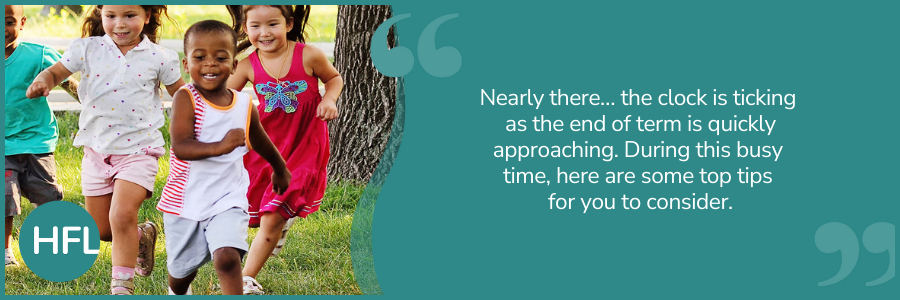
It’s that busy time of year and the clock is ticking to complete a list of things to do as another year quickly draws to an end. It goes without saying that some of us have had many challenges that we have continued to face on a daily basis, or some may have had a much smoother year. What remains and goes without saying is the huge impact that we all have in making a difference to the outcomes of children’s lives. As we look back, there is no doubt that we will find many examples of the milestones that children would have accomplished during their time with you and there is so much to celebrate. Reflect on all those magical moments that make you smile with pride knowing that YOU (regardless of what role you hold in your setting) influenced the progress that every child made!
So as we now approach the end of the year, a few top tips to consider before the school gate closes for our existing cohort of children:
As the term comes to an end, consider setting up activities where children are fully involved in washing up the resources and then sorting them as they replace them back in their original containers. Not only will this teach vital life skills, but it will equip them with understanding the importance of looking after resources and a whole wealth of other learning opportunities. Examples include, sorting, comparing, talking about similarities and differences, responsibility, pride, and care – enjoy and have fun!
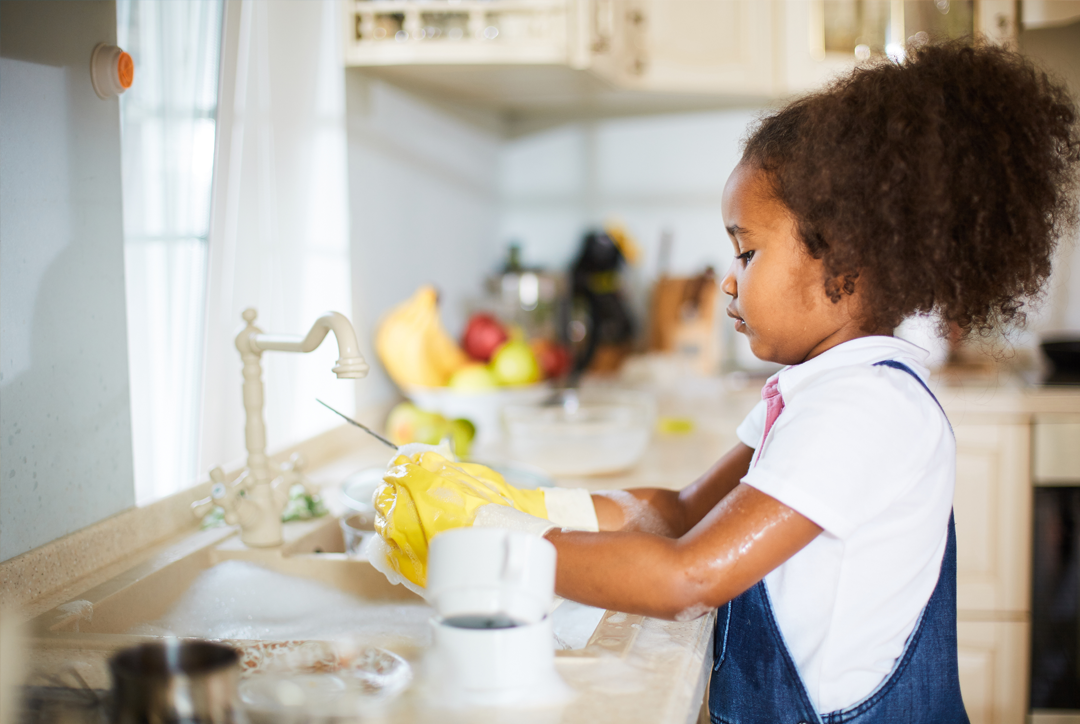
Now you have your Early Years Foundation Stage Profile (EYFSP) data, remember to analyse this information, and use it to support children’s transition to Y1 and key changes to the provision. Make time to meet your Y1 teacher and discuss each child’s individual attainment and the strengths of the whole class. It is important that during this time Y1 practitioners have ample opportunity to visit your EYFS to get to know the children and experiences that children engage in. As Diane Rich states – ‘look back to look head.’
Maximise the use of end of term open evenings/days/events to showcase and celebrate the learning throughout the year. Provide time to reminisce on all those special and magical moments that led to wonderful discoveries and learning. You may want to take photos of end of term events and displays to create a ‘book of memories’.
With your transition activities now underway don’t forget to maximise the use of the information received from parents and from previous settings, by meeting and talking to children to make adaptations to your learning environment so that you are fully ready and prepared to welcome your new cohort at the beginning of the new academic year.
Have you seen HfL’s cohort summary sheet which will help you to collate pertinent information for the new incoming cohort: EYFS entry cohort summary
Signpost parents to local events being run over the summer by family centres and other agencies or take a look at 50 things to do before you’re 5 in Hertfordshire.
Consider using Early Years Pupil Premium funding to ensure effective information sharing practices are in place to support smooth transitions for disadvantaged and vulnerable children by arranging cover for staff so that thorough handover meetings can take place.
Review the impact of resources and interventions that you have put into place this year to see if they have impacted on progress and/or closed the gap between Free School Meals (FSM) and non-FSM children. What changes will you make as a result to meet the needs of the children that are eligible for funding starting in September?
To help you, have you seen our ‘Making the Difference Early Years toolkit’? If you would like a free digital copy and find out more about how to improve outcomes for disadvantaged and vulnerable groups in the Early years then come along to our two part training: ‘Making the difference: improving outcomes for disadvantaged and vulnerable groups in the EYFS
As Early years practitioners we are experts at acquiring a wealth of resources, some that become ‘treasure’ and some that stack up and don’t get used. Or there are those that have taken up space in the learning environment for years and hardly accessed by children. You may already have identified these or are thinking ‘yes, I know which ones they are…’ Time to make that change and de-clutter.

When thinking about your new cohort, reviewing, making changes and setting up your learning environment, consider the use of our multi award winning resource Places to Play Every Day (3-5 year olds) for some inspiration and tools to help audit your provision.
Find a moment to map out the first week in the autumn term with your team to help the settling in process so that everyone is clear of their roles to help children and families have a happy, welcoming and enjoyable start. Agree on the most important aspects that will support the settling in process in line with your transition events.
The transition toolkit has a wealth of resources to support you with this.
Lastly, your wellbeing is absolute paramount. So as this busy term draws to an end, take time to reflect and review on the year with what has gone well and makes you feel proud. Take time to thank your team and all those that helped to make a difference including yourself. Most importantly, switch off, totally relax and enjoy the summer break in preparation for the new term. An exciting journey awaits with a new cohort to begin in September.

For more regular top tips from our team of Early Years Foundation Stage education specialists and to hear about our new training courses, resources, and blogs please subscribe to our mailing list.
Happy holidays!